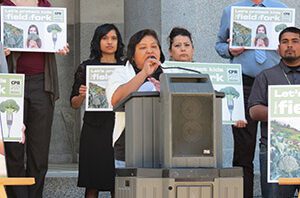FOR IMMEDIATE RELEASE – Thursday, March 13, 2014
Media Contacts:
Paul Towers, PAN, 916-216-1082
Irma Medellin, El Quinto Sol de America, 559-568-5749
Pesticide-contaminated communities call for ban
More than seven years since findings were presented, Californians who found chlorpyrifos in their air and bodies call for more restrictions on the pesticide
Food, farming, health and environmental groups present over 12,000 signatures in support of restrictions
 Irma Medellin
Irma Medellin
Sacramento, Calif – A group of San Joaquin Valley residents who found concerning levels of pesticides in their bodies more than seven years ago traveled to Sacramento today to urge state policymakers to protect children from a pesticide linked to impacts on health and learning.
“California officials can’t delay action any longer,” said Irma Medellin, executive director of El Quinto Sol de America and one of the San Joaquin Valley residents who tested the air around her home and tested her body for contamination. “Our air and bodies are polluted with the neurotoxic pesticide chlorpyrifos. It should be taken off the market immediately.”
Chlorpyrifos, an organophosphate pesticide, also commonly known as Dursban or Lorsban, is sprayed on crops across California, including citrus, grapes, broccoli and almonds. It regularly drifts onto neighboring communities, and is also found as residue on food. Over 1 million pounds are applied in California each year, even after federal officials cancelled its use in homes in 2001 because of the hazards posed to children’s developing brains and nervous systems.
San Joaquin Valley residents are frustrated by the lack of action, even though it’s been years since they found concerning levels of the pesticide in their air and bodies. In 2004-2006, residents near citrus groves collected over 300 air samples and found chlorpyrifos in more than ¾ of samples. In the third year, the findings were the most dramatic, with over a quarter of samples containing chlopyrifos at levels EPA deems of concern for infants.
In that year, 12 residents also tested their urine for a metabolite of chlorpyrifos. The metabolite was found in everyone’s urine, and all but one individual had levels well above the national average and above the level that EPA found could pose adverse health effects.
Residents from Central Valley communities were joined in Sacramento today by advocates from food, farming, health and environmental organizations who stressed that these stories apply to communities across the state.
“Children, especially farmworker children are on the frontlines of exposure and deserve better protections,” said Erik Nicholson, vice-president of United Farm Workers. “State officials have buried their head in the sand despite overwhelming evidence.”
Children living in farm communities are especially at risk. In addition to chlorpyrifos exposure from residues on food, they may also be breathing airborne chlorpyrifos drift from nearby farms in their classrooms and homes. Farmworker children are exposed even more, as parents can carry pesticide residues home at the end of the day on work clothing and shoes.
California’s Department of Pesticide Regulation has not conducted a comprehensive evaluation of chlorpyrifos in many years. Since then, the agency has gathered additional information about chlorpyrifos use in California’s air and water, and taken small steps to reduce the use of the chemical as an air pollutant.
Meanwhile, evidence from peer-reviewed studies about the harmful impacts of chlorpyrifos has grown, including a new review paper out this month in Lancet Neurology. At low doses, prenatal exposure to chlorpyrifos have been linked to significant adverse impacts on neurodevelopment, such as a 7-point decrease in IQ and alterations to brain architecture in 7-year-old children. Early childhood exposures have been linked to neurodevelopmental effects as well.
Researchers with the American Academy of Pediatrics and the American Congress on Obstetricians and Gynecologists have compiled recent research, and are urging policymakers to reduce the use of pesticides, like chlorpyrifos, that pose significant threats to children.
“Policymakers have enough evidence to act. Research from across the globe shows that chlorpyrifos is a powerful neurotoxic chemical, especially for children,” said Veena Singla, PhD, staff scientist with Natural Resources Defense Council. “Even low levels can cause significant harm if exposure occurs during vulnerable windows of fetal and childhood brain development.”
Valley residents from El Quinto Sol also delivered approximately 12,000 petition signatures calling for action on chlorpyrifos to the California Department of Pesticide Regulation earlier today, collected by the Center for Environmental Health, Natural Resources Defense Council, Pesticide Action Network, and United Farm Workers.
The petitions also underscore similar requests from 70-plus organizations who delivered a letter to California officials in January, calling on policymakers to eliminate the use of chlorpyrifos and take immediate steps to protect children from the chemical.
The problems with chlorpyrifos aren’t limited to fields. The chemical is also regularly found in testing conducted by the California Department of Pesticide Regulation and the U.S. Department of Agriculture. For the last year of sampling, California officials regularly found the pesticide on produce, including citrus and broccoli, grown inside the state. The state lists over 70 detections from sampling in 2012.
“From field to fork, chlorpyrifos is hazardous to children. It’s time to shift to prevention, and officials should start by reducing use. They can begin by eliminating the most antiquated application methods, including crop dusting and air blasting,” said Kristin Schafer, policy director of Pesticide Action Network, and a representative of the statewide coalition Californians for Pesticide Reform. “As we eliminate the use of chlorpyrifos, the state must also invest in cutting-edge alternatives to help farmers transition to a safer and more prosperous form of agriculture.”
Members of El Quinto Sol de America also planned to speak at a public health briefing on pesticides for legislators and their staff later in the day.
###
Resources
- Report :: A Generation in Jeopardy: How pesticides are undermining our children’s health and intelligence
- Profiles of California communities that found chlorpyrifos in air and their bodies
- Statement and policy recommendations from the American Academy of Pediatrics.
- Database of USDA sampling for chlorpyrifos residues on food







